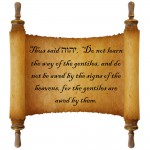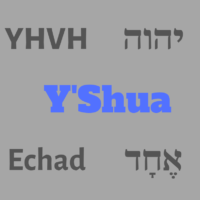It is almost time for the new biblical year to start, depending of course on the calendar you use. Which calendar to use is no easy decision and lately, when you say the word calendar, you may already create a controversy. The calendar is not a salvation issue, there should be no arguing about it. It should not divide us, and yet it does.
There are so many different calendars in use today. each one following their respective calendar believe they are right. There is the Sighted Moon calendar, the Hillel 2 calendar (known as the Jewish calendar), the Conjunction or dark moon calendar, the Essene calendar, to name but a few. You will also find calendars where the vernal equinox is used to determine the start of the new year. Other calenders use the barley for this purpose.
It is not our purpose to go into the detail of each of these calendars and tell you why we do or don’t agree with them. The purpose of this article is also NOT to create contention. We have received questions from people asking us why we follow the Sighted moon calendar, and this is our explanation..
That settles it for us because, when Y’shua came to earth, He came as an example to us. He came to show us how to live according to His instructions. Y’Shua instructed us, as His followers, on how to follow Him.
Imitate Y’shua
Here are his words:
Luke 9:23
23 And He was saying to them all, “If anyone wishes to come after Me, he must deny himself, and take up his cross daily and follow Me.
Y’shua said this quite a few times. So, what does this mean? If you take the word back to the Hebrew, it means the following:
FOLLOW [Heb yÄlaḵ Ë’aḥar (Gen. 24:5, 8, 39, etc.), Ë’aḥarê-ḵēn (Gen. 41:31), rÄá¸ap̱ (Gen. 44:4), reg̱el-‘at the foot of’ (Ex. 11:8), tûr (Nu. 15:39), Ë“Äśâ (2 S. 17:23), hÄlaḵ Ë’aḥar (Gen. 32:19; Dt. 4:3), Ë’aḥar-‘after’ (e.g., Nu. 14:24; 32:11; Dt. 12:30), zÄË“aq Ë’aḥar (Jgs. 6:34f; lit “be called together afterâ€), ḥÄyâ Ë’aḥar (1 S. 12:14), mÄÅ¡aḵ (Job. 21:33), yÄá¹£ÄË’ Ë’aḥar (2 S. 11:8), dÄḇēq-‘cling to’ (Jer. 42:16)]; AV also PURSUE AFTER, COME AFTER, WALK AFTER, GATHER AFTER, DRAW AFTER, etc.; NEB also GO AFTER, PURSUE, IMITATE, etc.2
Here is the Lexical Greek meaning, it is very similar.
199 ἀκολουθÎω (akoloutheÅ): vb.; ≡ Str 190; TDNT 1.210—1. LN 15.144 go/come behind, follow (Mk 11:9); 2. LN 15.156 accompany as follower (Mt 4:25); 3. LN 36.31 be a disciple (Mk 1:18)3
From these definitions, we learn that it means we are to do what He did in the way He did it, we are to imitate Him. We are to be His disciples. Keep this in mind as we continue here.
So, if we are to imitate Y’shua, we need to know what He did and in this case, which calendar He followed.
Which calendar did Y’shua keep?
Which calendar did Y’shua follow for the feasts? There are quite a few references in Scripture that prove that Y’shua went up to Jerusalem for the Pilgrimage festivals, as instructed in Torah.
The feast of Pesach (Passover)
Luke 2:41–42
41 Now His parents went to Jerusalem every year at the Feast of the Passover. 42 And when He became twelve, they went up there according to the custom of the Feast;
John 2:23
23 Now when He was in Jerusalem at the Passover, during the feast, many believed in His name, observing His signs which He was doing.
John 2:13
13 The Passover of the Jews was near, and Y’shua went up to Jerusalem.
The feast of Sukkot (Tabernacles)
John 7:2
2 Now the feast of the Jews, the Feast of Booths, was near.
John 7:10
10 But when His brothers had gone up to the feast, then He Himself also went up, not publicly, but as if, in secret.
The feast of Shavuot (Pentecost)
Y’shua’s disciples did as He taught them, they were all together in Jerusalem at the feast of Shavuot (Pentecost) when the Holy Spirit was given them.
Acts 2:1
1 When the day of Pentecost had come, they were all together in one place.
From these verses, we learn that Y’shua and His disciples went up to Jerusalem for the feasts as commanded in Torah. In some of these verses, the feasts are called the feasts of the Jews. Why is that? Here is David Stern’s commentary on John 7:1-3
Why is this significant, if at all? These references apply to the Judeans. There were at least two different calendars at the time of Y’shua, the Judean and the Samaritan, there is also speculation of a third, the Essene calendar, which may have been followed by the Galileans; we shall look into that later. We know Y’shua followed the calendar of the Temple, the Judean calendar. All these references prove that He went up to Jerusalem to the Temple to celebrate these feasts. Now, we need to determine which calendar was followed by the Judeans at the time of Y’shua. For this, we need to find historical references.
Historical references
We know from historical sources that the Jewish calendar, or Hillel II calendar, was only instituted between the year 359 to 500 CE; so what was used before this?
Our first historical source tells us about how the new moon was announced in the time of Herod’s Temple. Herod here, refers to Herod the Great and for those who don’t know, Herod the Great was the King at the time of Y’shua’s birth.
New Moon
The accurate determination of the new Moon was always of the utmost importance to the Hebrews, because if they were not precise with the exact time of the new moon it would upset their whole calendar, and the Lord of the calendar would be sought on the wrong days. If the Lord is indeed the Lord of times and seasons and designed a calendar, then it was their duty to observe it with accuracy and heart-felt passion.
During the time of Herod’s Temple the high priest was the one chosen to announce the New Moon from the Temple, based upon the testimony of two trustworthy witnesses. Once the announcement was made torches were lit on the Mount of Olives, which was a signal to those waiting upon other hills, even distant hills, that the New Moon had appeared over Jerusalem and to celebrate the New Moon with those even of the dispersion.5
Mention is made of two witnesses; what did they witness and how? Let’s search some more…
Then we have Philo of Alexandria; he was a Hellenistic Jewish philosopher, who lived in Alexandria, Egypt, during the Roman Empire. He was a contemporary of Y’shua (20BC – c. 50CE).8
Philo wrote about the observance of the festivals by the Jews of his time and here is a quote from The Works of Philo about the festival of the new moon. Here he describes in a very colorful, philosophical way how the new month was determined.
XXVI. (140) Following the order which we have adopted, we proceed to speak of the third festival, that of the new moon. First of all, because it is the beginning of the month, and the beginning, whether of number or of time, is honorable. Secondly, because at this time there is nothing in the whole of heaven destitute of light. (141) Thirdly, because at that period the more powerful and important body gives a portion of necessary assistance to the less important and weaker body; for, at the time of the new moon, the sun begins to illuminate the moon with a light which is visible to the outward senses, and then she displays her own beauty to the beholders. 9
There are other references from the Mishnah(Rosh. Hash. 1:3–2:1 C) that show that the Sighted moon method was still used 200 years after Y’shua to determine the new month. We will go into more detail about this in our follow-up article about the calendar.
Other historical calendar references
We shall look at three other references in which the calendar is referenced. The book of Enoch, the book of Jubilees and the Temple Scroll.
The book of Enoch
The book of Enoch was written 300 years before Y’shua. The first day of the new moon according to the book of Enoch is the day the light rises on the moon.
Enoch 78:12
12 And on the first day she is called the new moon, for on that day the light rises upon her.10
The end of the month is described as follows:
Enoch 78:14
14 On the side whence the light of the moon comes forth, there again she wanes till all the light vanishes and all the days of the month are at an end, and her circumference is empty, void of light.10
From this description, we learn that the conjunction is the end of the month and the new moon is when the light rises on the moon.
We can, however, not say this alone is proof of a sighted moon calendar, for two calendars were described in the book of Enoch. A solar and lunar calendar. We quoted this to show you what the understanding was regarding the concept “new moon.” The ancient understanding of “new moon” was the day on which the light rises on the moon, thus a crescent moon. The ancient understanding was not in line with the NASA concept of the dark moon being the new moon. On the contrary, the conjunction is clearly understood to be the end of the month.
Here is a quote from the Anchor Yale Bible Dictionary about these two calendars.
Here for the first time an extant Jewish document describes a full calendar; or, more precisely, the angel Uriel reveals its details to Enoch. In fact, it sketches two systems: a solar calendar of 364 days (72:32; 74:10, 12; 75:2; 82:4–6) and a lunar one of 354 days (73:1–7; 78:6–17). The solar year of 364 days takes a schematic form (the months are again numbered, not named): months 1, 2, 4, 5, 7, 8, 10, and 11 have 30 days, while months 3, 6, 9, and 12 have 31 (72:6–32).
But for neither the solar nor the lunar year does the writer mention intercalation; every year has the same number of days (cf. also 78:15–17; 79:3–5 where the lunar year is divided into twelve months: 1–3, 7–9 have 30 days; 4–6, 10–12 have 29 [but 78:9 mentions a month with 28 days]).11
The book of Jubilees
The Book of Jubilees, on the other hand describes a solar calendar. This is the same solar calendar that was described in the Book of Enoch. Here is a quote from the same source about this calendar in the book of Jubilees.
This solar calendar was also the one that was used by the Essenes who lived in the Qumran area. Vanderkam further wrote this about the intercalation problem which was evident in both the Enoch calendars.
The Temple Scroll
From these observations, we can conclude that both these calendars were flawed because it did not take intercalation into consideration. As we stated before, the solar calendar described in the book of Enoch and Jubilees was followed by the Essenes of Qumran, as described in the Temple Scroll found at Qumran. How do we know this was not the calendar followed at the time of Y’shua?
Enoch, Jubilees, and the Temple Scroll may have been written before the Qumran community settled on the shores of the Dead Sea, but the presence of copies of each testifies to the fact that they were used and studied at the Essene settlement. Hence it is not surprising to discover that the 364-day calendar is also attested among the sectarian documents. Indeed, it has been surmised that a calendrical dispute with the priestly establishment in Jerusalem was a precipitating factor in the exodus of the Essenes from Jerusalem to the Dead Sea. Evidence that the group followed a calendar that differed from the mainline one appears in 1QpHab 11:4–9 which indicates that the Wicked Priest—the archvillain for the covenanters and apparently the reigning high priest—appeared (at Qumran?) on the day of atonement. Since the ritual for this solemn day required that the high priest be at the temple, it is highly unlikely that he would have chosen this day for settling accounts with the Teacher of Righteousness. A reasonable inference is that the day of atonement fell on different days for the two protagonists because they lived by different cultic calendars.11
These people, the Essenes, were living separate from the other Jews and followed their own calendar, a solar calendar described in the book of Enoch and Jubilees. They did not use intercalation, which means their calendars were not in line with agricultural activities in the land of Israel. It may not have bothered them, for they were not primarily an agricultural society. This does not make their calendar right, though, for YHVH linked the calendar, specifically to the agricultural activities in the land. Look at the feasts, for example, they are all linked to the agricultural cycle of the land.
Why is it important to use the right calendar?
Speaking of the feasts; the appointed times described in the Bible are YHVH’s appointed times. He made these appointments with us and we are to keep it according to His command.
Leviticus 23:4
4 ‘These are the appointed times of YHVH, holy convocations which you shall proclaim at the times appointed for them.
Can I say I kept an appointment to have dinner with a friend, if I went the day after or before the date stated on the invitation? Think about this as this explains the importance of keeping the appointed times on the times YHVH appointed for them. We know from Scripture how many very significant prophecies have been fulfilled on YHVHs appointed times. Just think about the giving of the Ruach ha Qodesh on the feast of Shavuot. If the disciples kept another calendar, would they still have received the Ruach? Can we afford to miss any future fulfillment of Scripture?
Even after we have proven that the Sighted moon calendar was the calendar followed by Y’shua and His disciples, some will refuse to follow it based on their belief that it is based on a pagan idea.
The sighting of the new moon is not pagan!
Some say that we are not to sight the new moon, because it was and still is done by pagan nations. Did you know that all the major calendars (the sighted moon, conjunction-moon and solar )was used by pagan nations and could, for this reason, be seen as wrong? Is this a valid argument?
To answer this question, we will ask another question. Can we say the moon is pagan because it is worshiped by some? Or can we say any phase of the moon is pagan because it is used for determining a calendar by a pagan nation? If a group of people decide to worship bananas, would eating a banana be pagan? Alternatively, if they use bananas in the worship of their false god, does it make it wrong to eat a banana. Bananas were made for eating.
Similarly, the moon was created by YHVH, YHVH has given the heavenly bodies for signs and for seasons.
It is not pagan to observe a specific phase of the moon for the purpose of determining the beginning of the month. We are commanded not to worship the host of heaven; to look for the new moon at the beginning of the month is not worshipping the moon. For this reason, using a crescent moon to determine the new month is not pagan in any way.
Watch for the moon of Abib!
We also find some Scriptural proof to sight the moon. As we have seen in the previous section, YHVH made the moon for the seasons.
Psalm 104:19
19 He made the moon for the seasons; The sun knows the place of its setting.
The Hebrew word for seasons is “moadim”, appointed times. YHVH made the moon for the appointed times. We are to watch for the moon in order to know when the appointed times are.
We find prove of the sighting of the new moon in the book of Deuteronomy.
Deuteronomy 16:1
1 “Observe the month of Abib and celebrate the Passover to YHVH your Elohim, for in the month of Abib YHVH your Elohim brought you out of Egypt by night.
The word “observe”
9068 שָ×מַר (Å¡Ä·mÇŽr): v.; ≡ Str 8104; TWOT 2414—
1. LN 13.1–13.47 (qal) keep, i.e., cause a state or condition to remain (Job 2:6; Ps 17:4); (qal pass.) be kept, set aside (1Sa 9:24+); (hitp) keep oneself (2Sa 22:24; Ps 18:24[EB 23]+);
2. LN 37.119–37.126 (qal) guard, watch, i.e., limit access and movement of persons or objects in and out of an area, implying protection to or from the object being guarded (Ge 3:24); (qal pass.) be secured (2Sa 23:5; Ecc 5:12[EB 13]+), note: for qal act. ptcp. as noun, see 9070.5; 3
Here is another lexicon
I.שָ×מַר S8104 TWOT2414 GK9068465 vb. keep, watch, preserve (NH id.; Ph. שמר in n.pr. and (Pun.) = watchman; TelAm. Å¡imiru is perhaps overseer (Canaanism), WklNo. 80, 1, 23; Mand. ×¡×ž×™×¨× preserved NöM 46; cf. Arabic سَمَرَ (samara) converse by night, stay awake (v. LagBN 105); BaNB 175 f.; 43 infers from Ü¬Ü¶Ü¡ÜªÜ³Ü (temro) eyelid 12
From both of these Lexicons, and the others we have checked, we learn that “samar” means to keep, watch or observe. It is a verb, something we are to do. How do you observe or watch for something? With your eyes, and you can not observe what is not there…
The word “chodesh” was translated as month. This word means both moon and month in Hebrew.
2544 I. ×—Ö¹×“Ö¶×©× (ḥÅ·á¸Ä›Å¡): n.masc.; ≡ Str 2320; TWOT 613b—1. LN 67.174 month, calendar lunar month, i.e., a period of time as one full cycle of the moon (Ge 7:11; Ex 13:4), note: for MT text in Isa 66:22, see 2543; 2. LN 53 New Moon Festival, i.e., a religious festival (1Sa 20:5, 18, 24); 3. LN 53.16–53.27 New Moon Sacrifice (Ezr 3:5); 4. LN 23.46–23.60 unit: בְּ־ ×—Ö¹×“Ö¶×©× Ö¾Ö¸×”Ö¼ (b- ḥÅ·á¸Ä›Å¡ Ä-h) time of female heat, formally, in her month (Jer 2:24); 5. LN 67.163–67.200 unit: בֵּן ×—Ö¹×“Ö¶×©× (bÄ“n ḥÅ·á¸Ä›Å¡)1 a month old, formally, son of a month (Nu 3:15); 6. LN 67.163–67.200 unit: ×—Ö¹×“Ö¶×©× ×‘Ö°Ö¼Ö¾ ×—Ö¹×“Ö¶×©× (ḥÅ·á¸Ä›Å¡ b- ḥÅ·á¸Ä›Å¡)1 monthly, formally, month by month (Nu 28:14)3
Let us paraphrase this verse according to what we have learned: “ Watch for the moon of Aviv”
The heavenly bodies were given for signs and for seasons. A sign is visible, the new moon should thus be visible in order to be a new moon.
Can we sight the new moon wherever we are?
The answer is no, we are to start our new month according to the new moon sighted in Jerusalem. Why Jerusalem?
This is based upon scripture which places Jerusalem as the throne of Yahweh (Jeremiah 3:17), the centre-point of the law which will be given under Messiah (Isaiah 2: 3) through the waters of the Spirit (Zechariah 8:22; 14:8-21). God has placed His name there for ever (2 Chronicles 33: 4) 13
Now that we know we have to sight the new moon, and that we are to sight it in Jerusalem, we need to find out how to do it.
How are we to sight the new moon?
One advantage of the Sighted moon method is its simplicity. A child can sight the new moon. Here is a short description on where and how to look for the moon.
Various factors such as atmospheric pressure, temperature, humidity along the light path, altitude, latitude and longitude, fog, cloud/dust cover, glare etc. can all affect a first sighting. No one can infallibly predict the moment when the new moon will become visible to the naked eye. The general consensus of authoritative opinion is that a first sighting of the new moon could occur any time between about 15 and 48 hours after a conjunction. The conjunction being when the earth is between the sun and the moon in perfect alignment. The first sighting of the moon will be after the moon has moved out of this alignment.
In sighting the New Moon, one faces the western sky at sunset, drawing an imaginary line from the zenith overhead toward the setting sun, seeking the thin scimitar of light on either side of this imaginary line. The sun sets in the west slightly right of where the new moon will be seen. As the sky darkens the first star is seen which is actually the planet Venus. Gradually the crescent appears as a sliver just above the horizon. The faint New Moon will bulge out to the right, with the horns pointing toward the left. However, in early spring (autumn in southern hemisphere) the “Passover moon†will appear much like a saucer with both horns pointing upward. Variations of this New Moon may be seen in springtime. Biblical months are either 29 or 30 alternating days in length; at times two consecutive 30-day months may occur. Only on the new moon will the moon be invisible until the sun sets. It is as if Yahweh is concealing it so we will intentionally have to look for His sign in the sky.13
This bring us to the next point, when does the year begin?
When does the new year begin?
Exodus 12:2
2 “This month shall be the beginning of months for you; it is to be the first month of the year to you.
The month spoken of here is the month of Abib or Nissan. The month when the Passover is celebrated.
The beginning of the year is determined by both the sighting of the new moon and the barley being in the Abib stage. We have written an article about this topic earlier, so if you would like to learn more, you can read the article “Is the search for abib barley scriptural?”
Conclusion
Let us summarize what we have learned. We have learned that we as Y’shua’s disciples are to follow Him. Y’shua kept the Judean calendar, the calendar which determined the appointed times at that time He was on earth. This was the Sighted moon calendar, we found many historical references that attest to this.
Y’shua not only kept this calendar, but never rebuked anyone for keeping it, or made any negative remarks about this calendar. We know how outspoken He was if anything was in disagreement with Torah. Some will reason that He kept the calendar the majority kept. We will go into more detail about this in the next article; please subscribe to make sure you don’t miss that.
We have also learned a bit about the calendars described in the book of Enoch and Jubilees that the Essenes of Qumran kept. We have also seen why these are not in line with Scripture as it does not use intercalation, thus drifting off from the agricultural cycle.
We have also looked at why, where and how we are to sight the new moon as well as when the new year begins. We hope this has satisfied your curiosity and that you may even have learned something from this. Please let us know if we have left anything out or if you would like to add to this. We appreciate your feedback.
References
- All quoted passages are from the New American Standard Bible: 1995 Update. LaHabra, CA: The Lockman Foundation, 1995. We have substituted YHVH for LORD and Y’shua for Jesus.
- Bromiley, G. W. (Ed.). (1979–1988).The International Standard Bible Encyclopedia, Revised. Wm. B. Eerdmans.
- Swanson, J. (1997).Dictionary of Biblical Languages with Semantic Domains: Greek (New Testament). Oak Harbor: Logos Research Systems, Inc.
- Stern, D. H. (1996). Jewish New Testament Commentary : a companion volume to the Jewish New Testament (electronic ed., Jn 7:1). Clarksville: Jewish New Testament Publications.
- http://www.bible-history.com/jewishyear/jewishyear_new_moon.html
- Encyclopaedia Judaica, Vol. 12, p. 1039.
- http://en.wikipedia.org/wiki/Hebrew_calendar
- http://en.wikipedia.org/wiki/Philo
- Yonge, C. D. with Philo of Alexandria. (1995). The works of Philo: complete and unabridged (p. 581). Peabody, MA: Hendrickson.
- Charles, R. H. (Ed.). (2004). Pseudepigrapha of the Old Testament (Vol. 2, p. 244). Bellingham, WA: Logos Bible Software.
- Vanderkam, J. C. (1992). Calendars: Ancient Israelite and Early Jewish. In (D. N. Freedman, Ed.)The Anchor Yale Bible Dictionary. New York: Doubleday.
- Brown, F., Driver, S. R., & Briggs, C. A. (2000). Enhanced Brown-Driver-Briggs Hebrew and English Lexicon. Oak Harbor, WA: Logos Research Systems.
- http://en.wikibooks.org/wiki/Hebrew_Roots/New_Moon











Leave a Reply